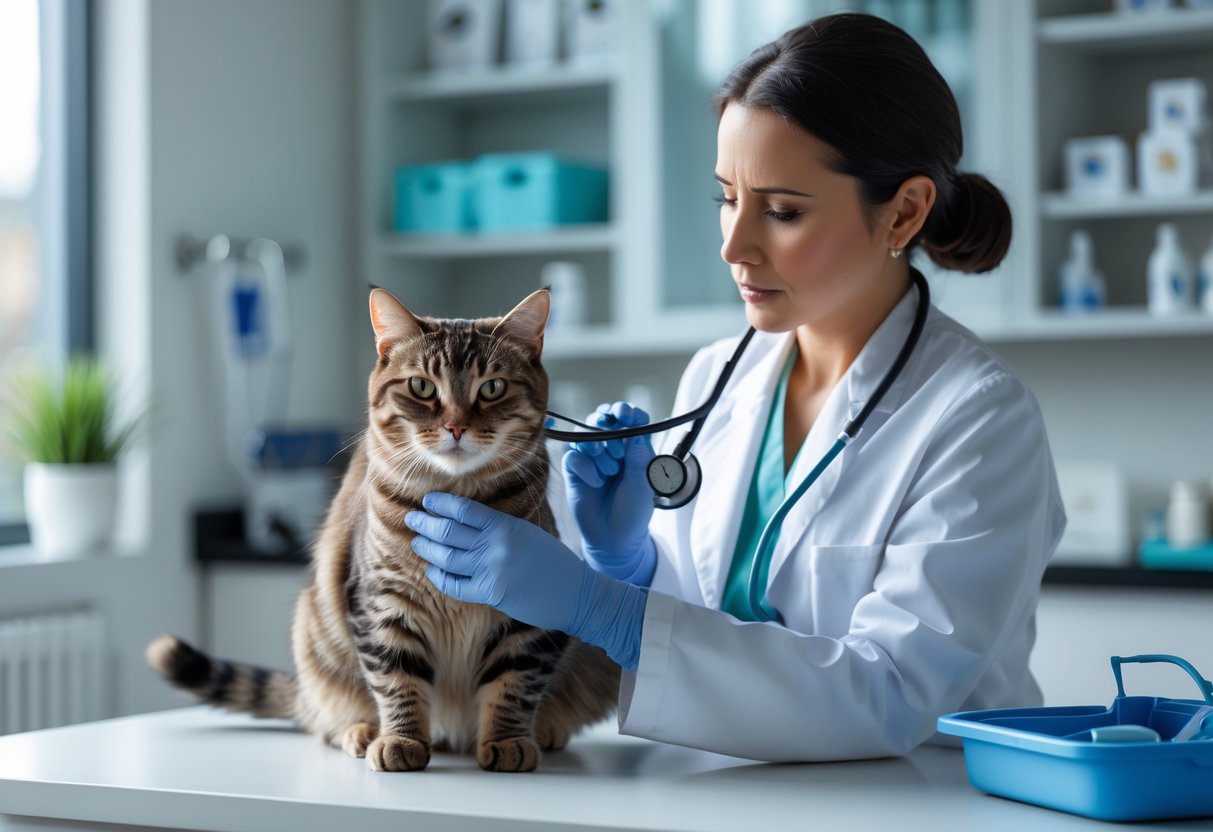Physical Address
304 North Cardinal St.
Dorchester Center, MA 02124
Physical Address
304 North Cardinal St.
Dorchester Center, MA 02124

Cats are known for sudden changes in mood, but it can be upsetting when a normally sweet cat becomes aggressive out of nowhere. Owners may find themselves shocked or hurt when their calm pet starts biting, scratching, or hissing for no clear reason. Most sudden aggression in cats comes from pain, fear, stress, or changes in their environment or health.

Some warning signs include flattened ears, swatting, growling, or a stiff body. Even small changes like a new person in the home, another animal, or changes in routine can upset a cat. There are also medical reasons, like illness or injury, that can make a cat lash out when touched. Learning to spot these signals helps owners keep themselves and their cats safe while they figure out what’s wrong.

Cats sometimes shift from calm to aggressive with little warning. Owners can spot early signs by watching changes in body language, behavior, and the way the cat interacts with people or other animals. Being able to recognize these clues is key to making a home safe and peaceful for both cats and their families.
Sudden feline aggression can appear in several ways. Biting, swatting with paws, scratching, and hissing are some of the most common signs. An aggressive cat might also lunge at people or other pets, chase them, or growl.
They can sometimes become tense and freeze before launching an attack. The suddenness can be confusing for owners. Increased vocalizations, such as yowling, or persistent tail-thumping, may also be clear warnings.
Some cats act aggressive only when someone gets too close to their territory or favorite spots. These behaviors can also be caused by pain, fear, or changes in their environment, which is discussed further at petmd.com. Take these signs seriously and address them early.
A cat’s body language often gives clues before they act out. Ears pinned flat against the head, a rapidly twitching or puffed-up tail, and dilated pupils are signs of stress or anger. The fur along their spine or tail might stand up, making them appear larger.
They may crouch low, with their body pressed toward the ground, showing they feel threatened. Sometimes, their back arches and they bare their teeth as a warning. Even subtle changes like flattened whiskers or a stiff gait can signal that a cat is about to become aggressive.
Learning these early signals helps people back off and give the cat space. It can prevent scratches, bites, or further escalation of their behavior.
Cats, especially kittens, often play by pouncing, chasing, and gentle biting. However, real aggression usually brings stronger force and more intense reactions. Playful cats have relaxed posture and often keep their claws retracted.
In contrast, a cat showing true aggression may have a stiff body, ears flat, and will bite or scratch hard enough to injure. The play stops immediately if the person or animal seems hurt, but aggressive cats may continue their actions.
Pay attention to vocal sounds too—playful kittens might make soft noises while truly aggressive cats hiss, growl, or shriek. For more about these differences, visit PetGuide.

Some cats may act out because they do not feel well. Health problems like pain, aging, and diseases can all lead to sudden aggression in cats.
When cats are in pain, they often react by being irritable or even lashing out aggressively. Even gentle handling can trigger a strong response if it causes discomfort. Pain-related aggression is common when a cat has sore joints, dental disease, injuries, or other painful conditions like arthritis.
Cats with chronic pain may not always show clear signs, so their sudden aggression can be confusing for owners. It is important for pet owners to notice changes like hiding, avoiding touch, or crying out when picked up. These behaviors may mean the cat is hurting. A visit to the veterinarian is needed to find and treat the source of pain. For more on medical triggers, read about common health-related aggression in cats.
Older cats might develop problems with their brains or nerves that make them act differently. This can include conditions like feline cognitive dysfunction, which is similar to dementia in people. Signs may be forgetfulness, confusion, or trouble recognizing family members.
Neurological disorders can also cause sudden aggression in cats. Some examples include brain tumors, epilepsy, or infections affecting the nervous system. These health problems may cause a cat to react quickly and strongly even when there is no clear threat. It is important to watch for changes in behavior, awareness, or movement. If any of these signs show up, it is time for a vet appointment.
There are many illnesses that can cause cats to suddenly act out. Some of the most common are hyperthyroidism, dental disease, and urinary tract infections. For example, hyperthyroidism raises the levels of thyroid hormones in a cat’s body, which can lead to restlessness, irritability, and episodes of feline aggression.
Other hidden conditions, like kidney disease or high blood pressure, may trigger mood swings or make a cat feel unwell enough to behave aggressively. Identifying and treating these underlying problems often helps reduce episodes of cat aggression. Regular check-ups and early detection are key to keeping cats happy and calm.

Cats may develop sudden aggression when they are afraid or when their home environment changes in ways that upset them. Spotting the cause can help keep both cats and people safer.
Fear is one of the most common reasons for sudden feline aggression. When a cat feels like it cannot escape a threat, it may lash out by hissing, swatting, biting, or scratching. The threat could be a loud noise, an unfamiliar animal, or even sudden movements from people.
Signs of fear and anxiety-induced aggression include:
A fearful cat may try to hide or avoid people before showing more obvious aggression. Sometimes, a cat becomes so stressed that even a gentle touch can set it off. It’s important to allow a scared cat space and avoid pushing it to interact. Understanding these signals can prevent bites and scratches. More detailed tips can be found in this cat aggression guide.
Cats are highly sensitive to changes in their surroundings, and even small changes can lead to sudden aggression in cats. Major triggers include moving to a new home, introducing new pets, rearranging furniture, or loud construction noises nearby.
A few examples of what might upset a cat:
Stressful changes can cause a cat to become territorial or defensive, which often appears as aggressive behavior. Making changes gradually and keeping some routines stable can help reduce stress-related aggression. When cats appear agitated after big changes, more advice is available on managing cat behavior after environmental stress.
Cat aggression can look very different depending on the cause. Some cats lash out over territory, while others get aggressive in response to petting or a stressful event.
Territorial aggression happens when a cat feels like a space or resource, such as food, toys, or even people, is being threatened. This type of feline aggression usually shows up when a new animal or person enters the cat’s home or when the environment changes.
Key signs include hissing, growling, swatting, and sometimes blocking doorways or chasing the intruder. Cats might attack pets or even people they see as outsiders. In multi-cat homes, fights can break out if the cats don’t have enough space. Introducing pets slowly and providing separate resources can help reduce these conflicts.
If you notice your cat is guarding spaces or picking fights after a new arrival, territorial aggression might be the cause. Understanding this can help owners manage the situation and prevent injuries.
Redirected aggression is confusing for many owners, because it seems like the cat is attacking “out of nowhere.” It often happens when a cat is upset by something it can’t reach or control, such as seeing another animal outside through a window or hearing a loud noise.
After becoming agitated, the cat may lash out at the closest person or animal, even if they had nothing to do with the original trigger. For example, a cat watching a rival outside could turn and bite their owner simply for walking nearby. Redirected aggression can be severe and may seem surprising because the real cause might not even be inside the home.
To prevent this, block your cat’s view of things that upset them and help them calm down before interacting again. Learn more about the causes and signs of redirected aggression in cats.
Some cats enjoy petting for a short time, then suddenly bite or scratch without warning. This is known as petting-induced aggression. It’s more common than people realize and can confuse even experienced cat owners.
The reason is often overstimulation; repetitive stroking can become uncomfortable for some cats. Warning signs include tail flicking, twitching skin, flattened ears, or a sudden tenseness in the body. Many cats will show at least one of these signals before reacting aggressively.
Giving the cat control over petting time and watching for body language cues can help. Taking breaks or stopping when a cat shows signs of irritation can reduce the chances of a sudden outburst. More details about petting-induced aggression reveal how to handle these situations safely.
Status-related aggression happens when a cat tries to control access to resources or assert its ranking over people or other pets. Affected cats may block doorways, growl when moved from a spot, or push others away from favorite resting areas. They can also demand attention or food forcefully.
This type of feline aggression often develops in spoiled or dominant cats who are used to getting their way. Owners might notice their cat becoming vocal, swatting, or biting if another pet or person gets attention first. The cat may also posture or use eye contact to challenge others.
Consistent rules and not rewarding pushy behavior can help curb status aggression. It’s helpful for owners to set clear boundaries and respond calmly if their cat acts out. For a deeper understanding of status aggression in felines, check out this explanation on aggression in cats.
Play aggression in cats is common and can be confusing. Pets often mix rough play with real aggression, which may lead to biting, scratching, or swatting that seems sudden or harsh.
Play aggression is when a cat uses biting, swatting, and scratching during play, but does not intend harm. The body language usually shows excitement or intense focus, not real fear or anger. For example, a cat might stalk, pounce, or chase a moving toy, then bite or scratch as part of the game.
Real aggression, on the other hand, usually includes more serious signs like flattened ears, growling, or hissing. These signs mean the cat feels threatened instead of playful. Owners sometimes mistake normal rough play for a real attack, but play aggression is a normal way for cats, especially young ones, to practice hunting skills. Making this distinction helps prevent misunderstandings and unnecessary punishments. For more on these differences, read about how to stop play aggression in cats.
To lessen play aggression, cats need good outlets for their energy. Toys that move or mimic prey, like feather wands, toy mice, or balls, help redirect their playful biting and scratching away from hands and feet.
Interactive play sessions, a few times each day, help burn off energy and strengthen the bond between cat and owner. It’s important to avoid using fingers or toes as toys. Instead, use safe cat toys so they learn the right way to play. If a cat gets too rough, stopping play and walking away teaches them that biting or swatting ends the game. This keeps play fun and safe for everyone involved.
Cat aggression is not just a behavior problem; it can also cause health issues for people and other pets. Scratches and bites from an upset cat can lead to injuries, and in some cases, even illness.
When a cat bites or scratches, it usually uses sharp teeth and claws. Puncture wounds from bites can look small but may go deep. Claw marks often result in red, bleeding lines.
Injuries from cats have a high chance of getting infected. This is because a cat’s mouth and claws carry bacteria. Common symptoms after a cat bite or scratch include redness, swelling, or pus. In rare cases, people may even need a doctor’s care for stitches or antibiotics.
Children, older adults, and people with weak immune systems are more likely to have a bad reaction to these injuries. Quick first aid, like washing the wound with soap and water, is important. Even after cleaning, it’s a good idea to watch for changes in the skin or signs of infection for several days. Aggressive cat behavior increases these risks.
Cat scratch fever is an illness caused by bacteria called Bartonella henselae. It spreads through bites or scratches that break the skin. The first signs in people may include swelling, a bump where the injury happened, fever, or feeling tired.
Most healthy people recover without treatment, but some can develop more serious problems. Lymph nodes, especially around the neck or underarms, can swell and hurt. Sometimes, people need antibiotics if symptoms get worse or don’t go away.
Young children and those with a weak immune system have a higher risk of problems from cat scratch fever. Preventing rough play and treating wounds right away can help lower the chances of getting sick. For more details, you can read about cat scratch fever and aggression risks.
Managing cat aggression means responding calmly and creating a safe space. Preventing feline aggression often involves changing routines, providing enrichment, and meeting the cat’s medical and emotional needs.
When a cat shows sudden aggression, owners should remain calm and avoid yelling, loud noises, or sudden movements. Backing away gives the aggressive cat space so it can calm down without feeling threatened.
Do not punish aggressive behavior, as this may increase fear and stress, leading to more aggression. Instead, focus on keeping everyone safe and removing any immediate triggers, like other pets or loud activities nearby. Look for warning signs such as growling, flattened ears, or twitching tails, and leave the cat alone if these occur.
For cats who bite, try redirecting their attention with toys or treats, and remember that patience is key. Consistent daily routines help reduce cat stress and make sudden aggression in cats less likely to happen. For tips on how to safely stop biting, try reading about how to stop a cat from biting.
If the aggressive cat’s behavior is frequent, severe, or causes injury, it’s important to consult a veterinarian. Medical issues like pain, dental problems, or hidden injuries can quickly lead to feline aggression. Ruling out illness is a critical first step.
If the vet finds no medical problems, a certified animal behaviorist can help develop a custom plan to manage aggression. This can include behavior training, positive reinforcement, and changes to the cat’s environment. Persistent aggression, aggression without warning, or sudden changes in your cat’s personality all call for professional help.
Cats can become aggressive for many reasons, such as stress, pain, or changes in their environment. Noticing sudden changes in their actions often means there’s an underlying issue that should be looked into.
Cats may become aggressive when they are scared, stressed, or feel threatened. Illness or pain can also lead to sudden angry outbursts. Sometimes, changes in routine, moving to a new home, or new people in the house can trigger these behaviors. Find more causes of sudden aggression in cats.
First, separate the pets safely to avoid injury. Avoid punishing either animal. Look for recent changes, like a new pet or rearranged furniture, which could affect their relationships. Slowly reintroducing the animals with supervised visits can help lower tension. Learn strategies for calming an aggressive cat.
Sudden mood swings or aggression may be a sign of pain, illness, or discomfort. Common health problems include arthritis, dental disease, or infections. It is important to visit a veterinarian if a cat’s personality changes quickly, as medical causes of aggression should be ruled out right away.
Give the cat space when it shows signs of irritation. Watch for body language like flattened ears or a swishing tail. Encourage play with toys, not with hands, to avoid mixed signals. If biting happens often, consulting a vet or a behavior expert for cats might be needed.
Although cats can have mood swings, sudden and lasting changes in personality are not typical. If a cat becomes aggressive or fearful very quickly, it may be feeling unwell or stressed. These shifts should not be ignored, as they can point to health or behavioral issues.
Give the cat a safe, quiet space to calm down and avoid trying to touch or pet it when it is upset. Watch its reactions to see if certain sights, sounds, or smells could be upsetting it. If growling and hissing continue, talking to a veterinarian or cat behaviorist can help identify the problem.